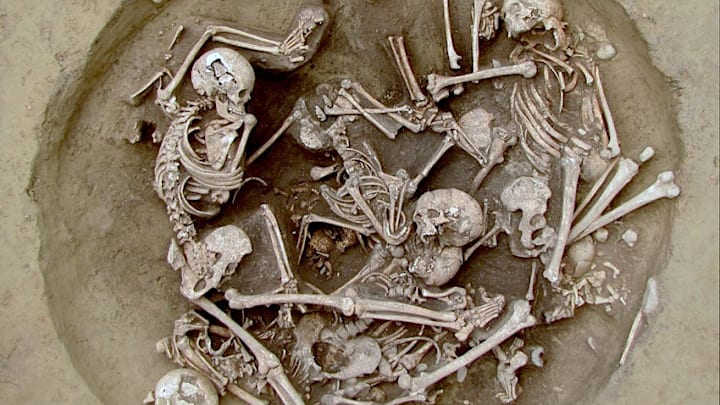Acts of excessive brutality have been an aspect of war for all of recorded history. New research on human remains at an archaeological site in France indicates they may have occurred even before that.
Beyond Bloodlust
A team of researchers from the University of Valladolid in Spain and other institutions examined 82 sets of skeletal remains from two archaeological sites, Achenheim and Bergheim, in northeastern France. The bones date back to between 4300 and 4150 BCE, putting them within the Neolithic era—the tail end of the Stone Age—when permanent settlements, farming, and cultural groups were all fairly new. These remains included severed limbs and skulls with unhealed fractures, indicating violent deaths by killers exhibiting bloodlust beyond what was needed to simply murder.
When the remains were discovered in 2016, archaeologists knew they were the result of a ruthless massacre, and even suspected that the perpetrators took the limbs as trophies, but they were not sure why. Intragroup collective punishment and the sacrifice of social outcasts were possibilities.
Now, stable isotope analysis is revealing more clues.
Isotopes Reveal Outsiders

For the new paper, published in Science Advances, the researchers examined isotopes of certain elements in the bones, the presence and combination of which can indicate where people lived, what they ate, and their travels while alive.
The team also analyzed the remains of 53 animals and 35 modern plants at Achenheim and Bergheim to establish the isotope baselines of the two sites. They discovered significant differences in the isotope “fingerprints” of the brutalized remains compared to those from bones that showed no signs of trauma, suggesting that the victims of violence were not native to the area.
You May Also Like:
- Hoard of Gold Coins Meant for Mercenaries Found in Ancient Greek City
- 10 Prehistoric Battle Sites Around the World
- 7 Misconceptions About the Stone Age
They were likely “members of a raiding party who were captured and subjected to capital punishment,” the authors write, and “that the severed upper limbs were trophies taken from the bodies of enemies fallen in battle or raids immediately after death.”
Possible Motives
But why the overkill? The researchers listed a few potential reasons. The local leaders may have tried to cement their authority over their own community through displays of violence on outsiders. They may also have sought “supernatural favor” before another battle or “paid tribute to [the] glory” of a past one by ritually depositing the remains in burial pits,
This behavior was likely new in the region at the time. The authors note that such brutality “has no previously known occurrences in the European Neolithic record” and doesn’t match the characteristics of other sites that archeologists think reveal the aftermath of the executions of a raiding party, which show no evidence of brutality. Ritualized killing was rare in such egalitarian societies, though the historic record shows it does happen in times of crisis.
At the time when these remains were deposited at the Achenheim and Bergheim sites, groups of people from the Paris Basin were moving through what is now northeastern France. Archaeological evidence of their fortifications and settlements, plus the remains of those seemingly killed in battle, suggest that a major invasion or conquest occurred between locals and outsiders, the authors write—”the consequences of which may have affected the lives of the region’s inhabitants for decades.”
Discover More Amazing Archaeology:
